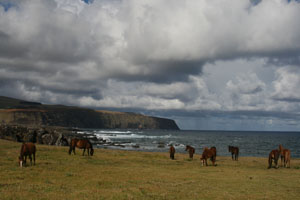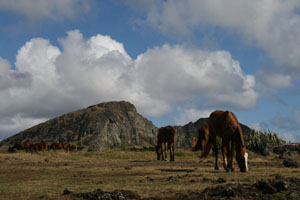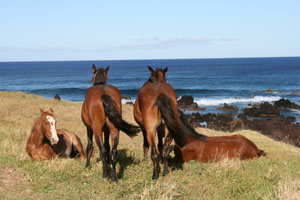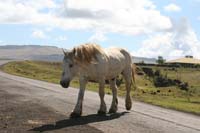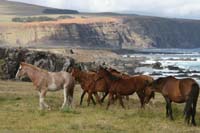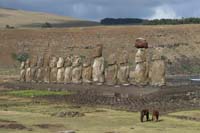
Home
Nov 14 - Landed || Nov 16 - Land of Horses and Moai! || A special place
Rapa Nui - the land and the people
The island horses
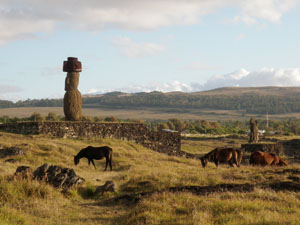 One of the most amazing things about this place is all of the horses! They are everywhere, on every part of the island. The horses were introduced in the early 1900's, and most accounts say there are currently around 1000 horses roaming the island. They roam through town, munching on the grass along the roads, wandering through people's yards, grazing on the grass in front of the church. Wandering at leisure through the archeological sites, scratching their hides on the ancient moai statues. I've never seen anything like it!
One of the most amazing things about this place is all of the horses! They are everywhere, on every part of the island. The horses were introduced in the early 1900's, and most accounts say there are currently around 1000 horses roaming the island. They roam through town, munching on the grass along the roads, wandering through people's yards, grazing on the grass in front of the church. Wandering at leisure through the archeological sites, scratching their hides on the ancient moai statues. I've never seen anything like it!
And, supposedly, every horse is owned by somebody. They all have brands. Though they don't seem confined by any fences or barriers, there do seem to be 'territories'. I watched several herds interacting once - the stallions posturing and squealing. Mares chasing others away. Younger horses playing attack and run games.
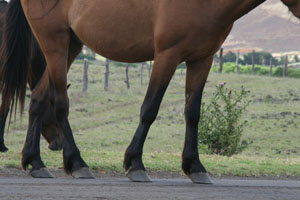 Steve and Dinah and I took an afternoon drive one day - just to check out the horses. There were definitely dominant strains in different areas. One group had a large number of white faces (I think we identified the bay stallion with a white face). Another group had a large number of roans. I wanted to see their feet too - there are some horses that get shod, but most of the stay barefoot all of their lives. They all have rock hard feet - though I was surprised at how poorly a lot of the feet were shaped. There were some with classic 'mustang feet' - and there were also a lot with very long, overgrown toes. This was a bit of a surprise. But we also noticed that many of the horses were in poor health - and these also tended to have the poorest feet.
Steve and Dinah and I took an afternoon drive one day - just to check out the horses. There were definitely dominant strains in different areas. One group had a large number of white faces (I think we identified the bay stallion with a white face). Another group had a large number of roans. I wanted to see their feet too - there are some horses that get shod, but most of the stay barefoot all of their lives. They all have rock hard feet - though I was surprised at how poorly a lot of the feet were shaped. There were some with classic 'mustang feet' - and there were also a lot with very long, overgrown toes. This was a bit of a surprise. But we also noticed that many of the horses were in poor health - and these also tended to have the poorest feet.
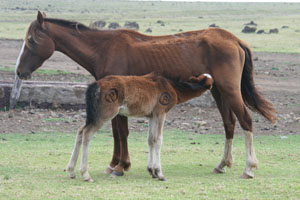 We found out later that many of the horses are suffering from ingesting a plant that was introduced as a control for soil erosion. Chocho - Crotolaria grahamiana - a member of the lupine family is extremely toxic to horses and cattle. If they eat enough of it they will eventually die - they can become blind, suffer neurological damage, and eventually liver failure. In one area in particular we saw several very ill looking horses. Too many horses, not enough forage, they will eat whatever they can find.
We found out later that many of the horses are suffering from ingesting a plant that was introduced as a control for soil erosion. Chocho - Crotolaria grahamiana - a member of the lupine family is extremely toxic to horses and cattle. If they eat enough of it they will eventually die - they can become blind, suffer neurological damage, and eventually liver failure. In one area in particular we saw several very ill looking horses. Too many horses, not enough forage, they will eat whatever they can find.
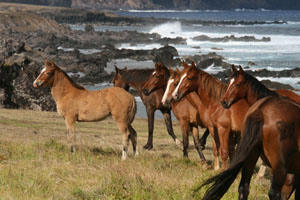 And as far as breed - phenotype - it was really a mix! Many of them looked like the criollo types (South America's native horse) - not too large, dense bone, good size feet - not heavily muscled, rather plain heads. Mostly a mix of chestnuts and bays, with a few strong roan strains showing in places. We did see a few odd ones that stood out! One gray draft or cob type stallion - he definitely looked out of place!
And as far as breed - phenotype - it was really a mix! Many of them looked like the criollo types (South America's native horse) - not too large, dense bone, good size feet - not heavily muscled, rather plain heads. Mostly a mix of chestnuts and bays, with a few strong roan strains showing in places. We did see a few odd ones that stood out! One gray draft or cob type stallion - he definitely looked out of place!
I had heard that most of the people still used horses for transportation. I think this is changing though. There are many more cars on the island now - even in the last 2 or 3 years more people are getting around by car or motorcycle. Though its still a common site for kids, adults, teens to be riding horses down the streets - sometimes with saddles, sometimes not. sometimes bridles, sometimes rope tied around the lower jaw and looped for reins. These people sit a horse like they were born on one. My first night here I woke up a few times to the sound of a horse galloping up the road, somebody going home after a night working or socializing in town.
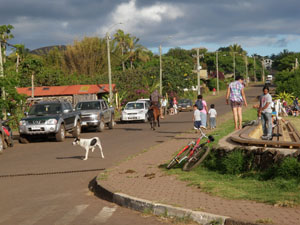
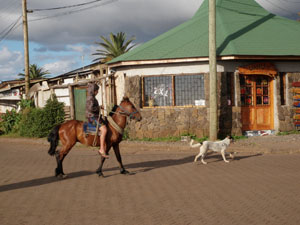 And there are also lots of dogs! They were all friendly, but many seemed homeless - following tourists around town looking for handouts. Chasing the occasional horse, for fun or as a 'job'. One dog was barking and barking and harassing a horse as his rider (a youth) headed up the street from the harbor - the boy stopped his horse, backed up to the dog, the horse struck out with a hind foot giving the dog a glancing blow - the dog yelped off - and the horse and rider continued up the road. So there!
And there are also lots of dogs! They were all friendly, but many seemed homeless - following tourists around town looking for handouts. Chasing the occasional horse, for fun or as a 'job'. One dog was barking and barking and harassing a horse as his rider (a youth) headed up the street from the harbor - the boy stopped his horse, backed up to the dog, the horse struck out with a hind foot giving the dog a glancing blow - the dog yelped off - and the horse and rider continued up the road. So there!
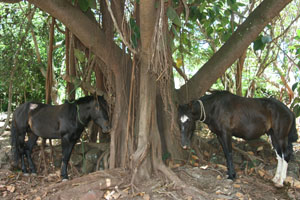 The islanders seem to consider the horses pests, yet they are very proud to own them and ride them and brag about the number of horses that they own. At some point the number of horses will have to be brought under control I suspect. There was a veterinarian that came to work the endurance ride (next story!) who is also a professor at a University in Chile. He is conducting a study on the island horses - the first ever done. He took samples of all the horses that were rounded up for the ride - skin, hair, blood, ear swabs - to study their chemistry. Effects of the crotolaria plant, general health. The horses are simply overgrazing the island. Attempts to re-establish trees and natural ground cover on the island are futile until the horses can be contained, or at least excluded from certain areas.
The islanders seem to consider the horses pests, yet they are very proud to own them and ride them and brag about the number of horses that they own. At some point the number of horses will have to be brought under control I suspect. There was a veterinarian that came to work the endurance ride (next story!) who is also a professor at a University in Chile. He is conducting a study on the island horses - the first ever done. He took samples of all the horses that were rounded up for the ride - skin, hair, blood, ear swabs - to study their chemistry. Effects of the crotolaria plant, general health. The horses are simply overgrazing the island. Attempts to re-establish trees and natural ground cover on the island are futile until the horses can be contained, or at least excluded from certain areas.
But it sure is beautiful to see the horses on the landscape!
Next - EnduranceX does polo and endurance!
Steph
